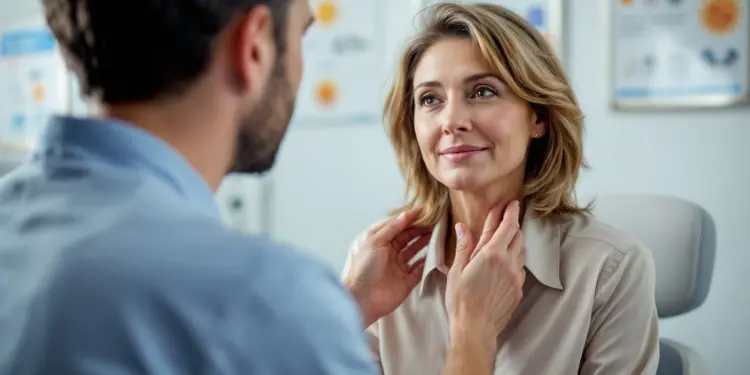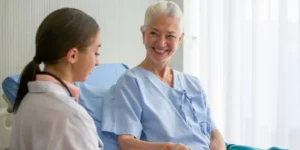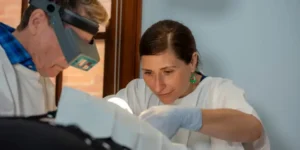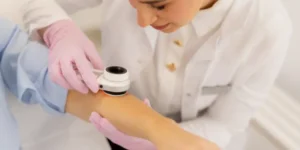Comprehensive Skin Checks at Leading Skin Cancer Clinic
Skin checks are vital for your health. In Australia, skin cancer rates are high. This blog explains skin checks at top clinics. Learn how to protect yourself.
Key Takeaways
- Skin checks are vital in Australia due to high skin cancer rates.
- Regular checks help spot skin cancer early, when it’s easier to treat.
- Doctors use special tools like dermatoscopes to see tiny skin changes.
- Skin Cancer clinics check over 100,000 patients and find 12,000 skin cancers yearly.
- 95% of skin cancers can be cured if found early, so book a check today.
Importance of Regular Skin Checks

Regular skin checks can save lives. They help spot skin cancer early, when it’s easier to treat.
Early Detection of Melanoma
Early detection of melanoma saves lives. Most people spot melanomas themselves or their partners do. Check your whole body in a bright room with a full-length mirror. Look for new spots or changes in old ones.
Use the ABCDE rule: Asymmetry, Border, Colour, Diameter, and Evolving. Watch for sores that itch, bleed, or don’t heal. Quick action matters – 95% of skin cancers can be cured if found early.
Self-checks are key, but expert help is vital too. Book a skin check at a clinic near you. Doctors use special tools to see details you might miss. They can spot early signs of melanoma and other skin cancers.
Regular checks boost your chances of catching problems early. This makes treatment easier and more effective.
Identifying Non-melanoma Skin Cancers
Non-melanoma skin cancers differ from melanoma but still need attention. Basal cell carcinoma (BCC) grows slowly and rarely spreads beyond the skin. Squamous cell carcinoma (SCC) grows faster and can spread if left untreated.
Both types often show up on sun-exposed areas. BCC may look like a pearly bump or a flat, scaly patch. SCC can appear as a firm, red nodule or a flat lesion with a scaly surface. Sunspots, also called actinic keratosis, can sometimes turn into SCC.
People with fair skin, many moles, or a history of skin cancer face higher risks. Regular skin checks help spot these cancers early.
What to Expect During a Skin Check
A skin check is quick and painless. Your doctor will look at your skin from head to toe with special tools.
Visual Examination by a Trained Professional
Trained pros do skin checks at top clinics. They look at your whole body for odd spots. These experts use special tools to see tiny changes. They check for three main types of skin cancer.
Early detection saves lives. That’s why we do thorough skin checks.
The SkinCheck process starts with a melanographer. They take photos of your skin. Then, a skin doctor looks at the images. This team approach helps catch skin cancer early.
Use of Dermatoscopes for Detailed Analysis
Dermatoscopes are key tools in skin checks. These special magnifying devices let doctors see skin spots up close. They show details not visible to the naked eye. MoleMap clinics use dermatoscopes in their full body imaging.
This helps find skin cancers early.
Doctors at MoleMap use dermatoscopes to check over 100,000 patients each year. Their careful checks lead to finding more than 12,000 skin cancers annually. Early detection is vital for better treatment outcomes.
After the skin check, patients get clear info about their results.
Types of Skin Cancer Screened
Skin cancer comes in different forms. We screen for the main types to catch them early.
Melanoma
Melanoma is the most serious type of skin cancer. It forms in cells that make melanin, the pigment that gives skin its colour. Melanomas often look like moles and can be black or brown.
But they can also be pink, red, purple, blue or white.
95% of skin cancers are treatable if diagnosed early.
Early detection is key to beating melanoma. The ABCDE rule helps spot warning signs: Asymmetry, Border irregularity, Colour changes, Diameter over 6mm, and Evolving size or shape. Most people find melanomas themselves or with help from a partner.
Next, we’ll look at other types of skin cancer screened during checks.
Basal Cell Carcinoma
Basal Cell Carcinoma (BCC) is the most common skin cancer in Australia. It grows slowly and rarely spreads beyond the skin. BCCs often look like small, pink, or pearly bumps on sun-exposed areas.
Over 95% of BCCs link to UV radiation from the sun or tanning beds.
Doctors can treat BCCs in many ways. Options include surgery, creams, or radiation. Early detection is key for easier treatment. People with fair skin, many moles, or a history of skin cancer face higher risks.
Regular skin checks help spot BCCs early.
Squamous Cell Carcinoma
Squamous Cell Carcinoma (SCC) grows fast and can spread if left alone. It often starts from sunspots on the skin. UV rays from the sun cause over 95% of skin cancers, including SCC.
People with fair skin, many moles, or past skin cancer are at higher risk.
SCC needs quick action. Doctors use special tools to spot it early. They look for changes in skin colour and texture. Next, we’ll explore what happens during a skin check at a top clinic.
After the Check: Understanding Your Results
After your skin check, you’ll get clear results. Your doctor will explain what they found and what to do next.
Explanation of Findings
After your skin check, a doctor will explain the results. They’ll point out any spots that need watching or treating. The doctor uses a special tool called a dermatoscope to look closely at your skin.
This helps them see tiny details that might be missed by the naked eye.
Early detection is key in skin cancer treatment.
You’ll get clear info about what was found during your check. If needed, the doctor will suggest next steps. This might include follow-up visits or treatments. MoleMap offers full body imaging and expert diagnosis by dermatologists.
This gives you a complete picture of your skin health.
Recommendations for Follow-up or Treatment
Your doctor will provide guidance following your skin examination. They may indicate that everything is fine and recommend a follow-up in a year. Alternatively, they might identify an area of concern and request an earlier return visit.
If they detect a potentially problematic spot, they’ll recommend its removal. This could involve a minor incision or cryotherapy. Some areas may require further testing for confirmation.
MoleMap provides comprehensive body imaging and professional assessment. This aids in monitoring skin changes over time. Individuals at higher risk might require examinations every six months.
1. What is a Skin Cancer Clinic and Why Should You Visit One?
A skin cancer clinic is a specialised medical facility focusing on the detection, diagnosis, and treatment of skin cancer. In a country like Australia, where exposure to UV radiation is high, these clinics play an essential role in public health. Clinics offer services such as mole checks, skin cancer screenings, and advanced diagnostic tools to identify skin changes and detect skin cancer early.
Why a Skin Cancer Clinic is Important
Visiting a skin cancer clinic provides individuals with professional, comprehensive care that goes beyond self-examination. These clinics use advanced technology like skin microscopes and total body photography to monitor and track skin changes. By visiting a clinic, patients benefit from the expertise of dermatologists specialising in skin cancer, ensuring early detection and intervention, which are key to successful treatment.
2. Why is Early Skin Cancer Detection Crucial?
Early detection of skin cancer significantly increases the chances of successful treatment and reduces the likelihood of cancer spreading. When caught early, skin cancers like melanoma, basal cell carcinoma, and squamous cell carcinoma can often be treated before they become life-threatening.
How Early Skin Cancer Detection Saves Lives
Early detection allows for less invasive treatments and can prevent the need for extensive surgery or chemotherapy. Regular skin checks help identify suspicious moles and lesions before they progress. According to Cancer Council Australia, individuals who detect skin cancer early are more likely to experience positive health outcomes, making early detection a critical aspect of skin care.
3. Who Should Get a Skin Cancer Check?
A regular skin cancer check is beneficial for everyone, but certain individuals may be at a higher risk. Those with a family history of skin cancer, a high number of moles, or fair skin should prioritise skin checks.
High-Risk Factors for Skin Cancer
- Family History of Skin Cancer: People with close relatives diagnosed with skin cancer should have regular checks, as genetics play a role in cancer risk.
- Number of Moles: Individuals with many moles, particularly large or irregular moles, should be more vigilant, as this increases skin cancer risk.
- UV Exposure and Skin Type: Fair-skinned individuals and those with a history of sunburn are also at a heightened risk for developing skin cancer.
Regular skin checks are particularly important for these groups to ensure any changes are detected and managed early.
4. What to Expect During a Skin Cancer Check
A skin cancer check at a clinic typically involves a comprehensive skin exam. During the appointment, a dermatologist or trained professional examines the entire skin surface for suspicious moles, lesions, or other signs of skin abnormalities.
Technology and Techniques Used in Skin Checks
Clinics often use tools like skin microscopes to examine moles in detail. Additionally, total body photography may be recommended for high-risk individuals to monitor changes over time. Some clinics, such as MoleMap skin cancer clinics, offer advanced imaging technology that provides a close look at suspicious moles, allowing for precise monitoring and early intervention when necessary.
The thoroughness of these exams provides peace of mind and ensures that any signs of skin cancer are addressed promptly.
5. How to Monitor Your Own Skin for Changes
While professional skin checks are essential, it’s also crucial to monitor your skin between visits to a clinic. Self-examination allows you to spot potential issues early and seek professional advice if necessary.
Tips for Self-Checks
- Look for Changes: Pay attention to new moles, changes in existing moles, or any suspicious skin lesions.
- Use a Mirror: Check hard-to-see areas, such as your back, with the help of a mirror or a partner.
- Note the ABCDEs: Check for Asymmetry, Border irregularity, Colour changes, Diameter over 6mm, and Evolving size, shape, or colour in moles.
By taking the time to monitor your own skin, you increase the chances of detecting skin cancer early and reducing risk.
6. The Importance of Regular Skin Cancer Checks
A regular skin cancer check is vital for everyone, particularly for those in high-risk categories. Skin cancer is one of the most common cancers in Australia, but regular checks can lead to early detection, increasing the likelihood of effective treatment.
How Often Should You Get a Skin Check?
Experts recommend an annual skin cancer check for most people. However, individuals with higher risk factors, such as a family history of skin cancer or a high number of moles, may need more frequent visits. Regular checks provide the opportunity to detect any suspicious moles or lesions, allowing for early intervention and improving skin health.
7. Understanding Different Types of Skin Cancer
There are different types of skin cancer, including melanoma, basal cell carcinoma, and squamous cell carcinoma. Each type varies in severity and treatment methods, making it essential to understand the risks associated with each.
Common Types of Skin Cancer
- Melanoma: The most dangerous form of skin cancer, melanoma can spread quickly if not detected early. It often appears as a new mole or a change in an existing one.
- Basal Cell Carcinoma (BCC): BCC is more common and less aggressive than melanoma. It usually appears as a pearly bump on the skin and rarely spreads to other areas.
- Squamous Cell Carcinoma (SCC): SCC may look like a red, scaly patch or a sore that doesn’t heal. While it’s more aggressive than BCC, it’s also treatable if detected early.
Understanding these types helps individuals recognise potential signs of skin cancer and seek prompt care.
8. What to Do if You Notice a Suspicious Mole
Spotting a suspicious mole can be concerning, but taking action promptly is essential for early diagnosis and treatment. If you notice any mole that looks unusual or has changed in appearance, book an appointment at a skin cancer clinic.
Steps to Take
- Monitor the Mole: Keep an eye on any moles that seem unusual or have changed over time. Track changes with photographs if necessary.
- Get a Skin Check: Schedule a check-up with a dermatologist or skin cancer check clinic to assess the mole thoroughly.
- Consider a Referral: If your GP or dermatologist sees a suspicious mole, they may recommend further testing or a biopsy to confirm the diagnosis.
Promptly addressing any concerns about moles can make a significant difference in outcomes and prevent potential complications.
9. How Skin Cancer Clinics Help You Stay Skin Safe
Skin cancer clinics, such as MoleMap skin cancer clinics, provide comprehensive services aimed at keeping individuals skin safe. These clinics specialise in skin cancer detection, offering detailed checks, monitoring options, and personalised advice for reducing skin cancer risk.
Preventing Skin Cancer Through Clinics
- Regular Monitoring: Clinics keep a record of your skin checks, allowing for double check comparisons and tracking changes over time.
- Education and Advice: Staff provide information on sun protection and lifestyle tips to reduce your skin cancer risk.
- Access to Specialists: With training in skin cancer detection, clinic specialists are well-equipped to diagnose and treat suspicious lesions.
By regularly visiting a skin cancer clinic, you’re taking proactive steps to reduce your risk and ensure long-term skin health.
10. Finding a Skin Cancer Check Clinic Near You
Finding a clinic near you that offers skin cancer screening services is an important step toward maintaining your health. Many dermatology practices and dedicated skin cancer clinics provide comprehensive screening options.
Tips for Choosing a Clinic
- Look for Specialisation: Choose a clinic specialising in skin cancer detection service to ensure you receive expert care.
- Check for Qualifications: Verify that the clinic’s practitioners have appropriate training and experience in skin cancer diagnosis and treatment.
- Book an Appointment: Once you’ve identified a clinic, schedule your check-up, especially if you notice any suspicious moles or changes in your skin.
For those with a high-risk of skin cancer, finding a reliable clinic can make a significant difference in managing skin health proactively.
Summary: Key Takeaways for Skin Cancer Check Clinics
- Visit a Skin Cancer Clinic: Regular visits to a specialised clinic are essential for early detection and treatment of skin cancer.
- Prioritise Early Detection: Early detection of skin cancer increases treatment success rates and reduces the need for invasive procedures.
- Understand Risk Factors: High-risk groups, including those with a family history or a high number of moles, should have regular checks.
- Monitor Your Own Skin: Conduct self-checks between clinic visits and watch for changes in suspicious moles or lesions.
- Choose the Right Clinic: Select a clinic with qualified practitioners and advanced tools for accurate diagnosis and comprehensive care.
Taking these steps will help you stay proactive about your skin health, reducing the risk of serious complications and ensuring peace of mind. If you’re considering a skin check, there’s no better time than now to book an appointment and get your skin thoroughly examined.
Conclusion
Regular skin checks save lives. Book your check today at a leading skin cancer clinic. Trained pros use top tools to spot issues early. Early detection means better outcomes. Take charge of your skin health now.
FAQs
1. Why should I get a skin cancer check?
Early detection is key. Skin cancer can appear anywhere… even in spots you can’t see. A full skin check at a leading skin cancer clinic helps spot issues early. It’s vital for Aussies, as we’ve got a higher risk of skin cancer due to our sunny climate.
2. How often should I get my skin checked?
It depends on your skin type and risk factors. Most people should get an annual skin check. But if you’re high-risk – like fair-skinned or with a family history – you might need more frequent checks. Your GP or skin specialist can advise the best schedule for you.
3. What happens during a comprehensive skin check?
A trained doctor will examine your skin from head to toe, using special tools like a dermatoscope. They’ll look for any suspicious spots or changes. It’s quick, painless, and could save your life. They might take photos to monitor changes over time.
4. Can I check my own skin between clinic visits?
Absolutely! Get to know your skin. Use a mirror to check hard-to-see areas, or ask a mate to help. Look for new moles, changes in existing ones, or anything unusual. The free SunSmart app can help you track changes. But don’t skip professional checks – they’re crucial.
5. Are all skin cancers serious?
Not all skin cancers are equal. Some, like melanoma, can be deadly if not caught early. Others, like basal cell carcinoma, are less risky but still need treatment. Early detection makes a huge difference – most skin cancers are curable if found early.
6. How can I reduce my risk of skin cancer?
Sun safety is key! Slip on a shirt, slop on sunscreen, slap on a hat, seek shade, and slide on sunnies. Avoid tanning beds – they’re bad news. Check your skin regularly, and book a professional check at least yearly. Remember, prevention and early detection are your best mates in fighting skin cancer.





